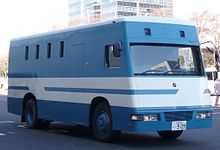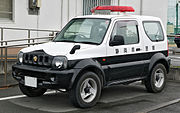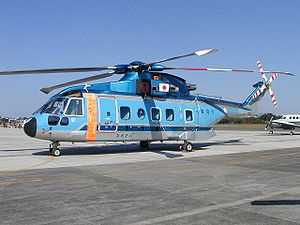National Police Agency (Japan)
| National Police Agency 警察庁 Keisatsu-chō | |
| Abbreviation | NPA |
 | |
| Logo of the National Police Agency. | |
| Agency overview | |
|---|---|
| Formed | 1954 |
| Employees | 7,721 (2013) |
| Annual budget | ¥258,344M (FY 2005/6) |
| Legal personality | Governmental: Government agency |
| Jurisdictional structure | |
| National agency | Japan |
| General nature |
|
| Operational structure | |
| Civilians | 4,900 |
| Parent agency | National Public Safety Commission |
| Child agencies |
|
| Bureaus | 5
|
| Regional Bureaus | 7
|
| Website | |
| www.npa.go.jp/english/index.htm (English) www.npa.go.jp (Japanese) | |
| Footnotes | |
| See the reference[1] below for the source of the above data. | |




The National Police Agency (警察庁 Keisatsu-chō) is an agency administered by the National Public Safety Commission of the Cabinet Office in the cabinet of Japan, and is the central coordinating agency of the Japanese police system.
Unlike comparable bodies like the U.S. Federal Bureau of Investigation, the NPA does not have any police officers of its own. Instead, its role is to determine general standards and policies, although in national emergencies or large-scale disasters the agency is authorized to take command of prefectural police forces. Policy for the NPA in turn is set by the National Public Safety Commission.
Organization
- Commissioner-General of the National Police Agency, the Highest ranking police officer (警察庁長官 Keisatsu-chō Chōkan)
- Deputy Commissioner-General (次長 Jichō)
- Commissioner-General's Secretariat (長官官房 Chōkan Kanbō)
- Community Safety Bureau (生活安全局 Seikatsu Anzen-kyoku)
- Criminal Investigation Bureau (刑事局 Keiji-kyoku)
- Organized Crime Department (組織犯罪対策部 Soshiki Hanzai Taisaku-bu)
- Traffic Bureau (交通局 Kōtsū-kyoku)
- Security Bureau (警備局 Keibi-kyoku)
- Foreign Affairs and Intelligence Department (外事情報部 Gaiji Jōhō-bu)
- Info-Communications Bureau (情報通信局 Jōhō Tsūshin-kyoku)
- National Police Academy (警察大学校 Keisatsu Dai-gakkō)
- National Research Institute of Police Science (科学警察研究所 Kagaku Keisatsu Kenkyū-sho)
- Imperial Guard Headquarters (皇宮警察本部 Kōgū-Keisatsu Honbu)
- Regional Bureaus
- Tohoku Regional Police Bureau (東北管区警察局 Tōhoku Kanku Keisatsu-kyoku)
- Kanto Regional Police Bureau (関東管区警察局 Kantō Kanku Keisatsu-kyoku)
- Chubu Regional Police Bureau (中部管区警察局 Chūbu Kanku Keisatsu-kyoku)
- Kinki Regional Police Bureau (近畿管区警察局 Kinki Kanku Keisatsu-kyoku)
- Chugoku Regional Police Bureau (中国管区警察局 Chūgoku Kanku Keisatsu-kyoku)
- Shikoku Regional Police Bureau (四国管区警察局 Shikoku Kanku Keisatsu-kyoku)
- Kyushu Regional Police Bureau (九州管区警察局 Kyūshū Kanku Keisatsu-kyoku)
- Communications Departments
- Tokyo Metropolitan Police Info-Communications Department (東京都警察情報通信部 Tōkyō-to Keisatsu Jōhō Tsūshin-bu)
- Hokkaido Police Info-Communications Department (北海道警察通信情報部 Hokkaidō Keisatsu Tsūshin Jōhō-bu)
Rank
Police officers are divided into nine ranks:[2]
- Commissioner General (Japanese: 警察庁長官 Keisatsu-chō Chōkan): The Chief of National Police Agency. The rank outside. 1 capacity.
- Superintendent General (警視総監 Keishi-sōkan): The Chief of Metropolitan Police Department. 1 capacity.
- Superintendent Supervisor (警視監 Keishi-kan): Deputy Commissioner General, Deputy Superintendent General, The Chief of Regional Police Bureau, The Chief of Prefectural Police Headquarters, others. 38 capacity.
- Chief Superintendent (警視長 Keishi-chō): The Chief of Prefectural Police Headquarters.
- Senior Superintendent (警視正 Keishi-sei): The Chief of Police Station(large). More than this rank, all police officer join to National Police Agency.
- Superintendent (警視 Keishi): The Chief of Police Station(small or middle), The Vice Commanding Officer of Police Station, Commander of Riot Unit.
- Police Inspector or Captain (警部 Keibu): Squad Commander of Police Station, Leader of Riot Company.
- Assistant Police Inspector or Lieutenant (警部補 Keibu-ho):Squad Sub-Commander of Police Station, Leader of Riot Platoon. National Police Officer 1st class's career start from this rank.
- Police Sergeant (巡査部長 Junsa-buchō):Field supervisor, Leader of Police box. National Police Officer 2nd class's career start from this rank.
- Senior Police Officer or Corporal (巡査長 Junsa-chō): Honorary rank of Police Officer.
- Police officer, old Patrolman (巡査 Junsa):Prefectural Police Officer's career start from this rank.
The NPA Commissioner General holds the highest position of the Japanese police.[3] His title is not a rank, but rather denotes his position as head of the NPA. On the other hand, the MPD Superintendent General represents not only the highest rank in the system but also assignment as head of the Tokyo Metropolitan Police Department.[3]
Transportation
Ground
In Japan, there are about 40,000 police vehicles nationwide with the average patrol cruisers being Toyota Crowns and Nissan Crews and similar large sedans, although small compact and micro cars are used by rural police boxes and in city centers where they are much more maneuverable. Pursuit vehicles depend on prefectures with the Honda NSX, Subaru Impreza, Subaru Legacy, Mitsubishi Lancer, Nissan Skyline, Mazda RX-7, and Nissan Fairlady Z are all used in various prefectures for highway patrols and pursuit uses.
With the exception of unmarked traffic enforcement vehicles, all Japanese police forces are painted and marked in the same ways. Japanese police vehicles are painted black and white with the upper parts of the vehicle painted white. Motorcycles are usually all white and riot control and rescue vehicles are painted a steel blue.
-
Daihatsu Atrai Police Kei van
-

Daihatsu Mira Police Kei car
-

Mitsubishi Diamante Police Car
-

Honda NSX Police Car
-

Mitsubishi GTO Police Car
-

Nissan 350Z police car
-
Nissan Cedric Police Car
-

Nissan Crew Police Car
-

Nissan Skyline GT-R Police Car
-

Subaru Impreza WRX STi Police Car
-

Subaru Legacy Police Car
-
Suzuki Jimny Police Jeep
-

Saitama prefecture Toyota Crown Traffic Police Car
-

Suzuki Address V125 Police Scooter
-
Suzuki Bandit (front) and a Honda VFR750 (back)
-
Unmarked Mitsubishi Delica Space Gear Police Van
-

Unmarked Nissan Bluebird Police Car
-

Unmarked Toyota Land Cruiser Prado SUV
-

Toyota Land Cruiser Kidotai (Riot Police) Unit
-

Mitsubishi Fuso Fighter Kidotai (Riot Police) Unit
-

Isuzu Giga Kidotai/Prisoner Transport Unit
-

Two Isuzu Erga Mio Buses in front of Yasukuni Shrine with a Uyoku noise truck (Gaisensha) passing in front
-
Security Police officer in a Mercedes-Benz S600 during escort duty at the 34th G8 summit in Tōyako, Hokkaidō.
-

Hino Ranger / Rescue truck
-

Unimog / Multi-purpose disaster management truck
-

Mitsubishi Fuso Canter / NBC defense truck
-

Hino Ranger / Explosive processing tools transportation truck
Aviation
Helicopters are extensively used for traffic control surveillance, pursuit of suspects, rescue and disaster relief. Total of 80 small and medium-sized helicopters are being operated in 47 prefectures nationwide.
-
Hokkaidō Police, Agusta A109E
-
Hokkaidō Police, Bell 412EP
-

Osaka Police, Eurocopter AS365 N2
Watercraft
Japanese police boats are deployed to major ports, remote islands and lakes, where they are used for water patrol and control of illegal immigration, smuggling and poaching. Ranging from five to 23 meters long, there are about 190 police boats nationwide.
-

Nagasaki Prefectural Police
-
Hokkaido Police
-

Hyōgo Police
Bodies supervised by the NPA
- 47 Prefectural Police Departments with the Tokyo Metropolitan Police Department.
National Police Agency Imperial Guard
See also
- Police services of the Empire of Japan
- Law enforcement in Japan
- Public order and internal security in Japan
References
- ↑ "Police of Japan". National Police Agency. Archived from the original on 2008-02-22. Retrieved 2008-08-06.
- ↑ "Metropolitan Police Department Organization Chart". Tokyo Metropolitan Police. Archived from the original on 2012-02-15. Retrieved 2012-02-15.
- ↑ 3.0 3.1 "Description of the Japanese Police Organization". Archived from the original on 2011-07-06. Retrieved 2012-02-15.
External links
| Wikimedia Commons has media related to National Police Agency (Japan). |
- Official website
- (Japanese) Official website
| ||||||||||||||||||||||||||||||
| ||||||||||||||||||||||||||||||||||||||||||||||||||
| Wikimedia Commons has media related to Police of Japan. |











